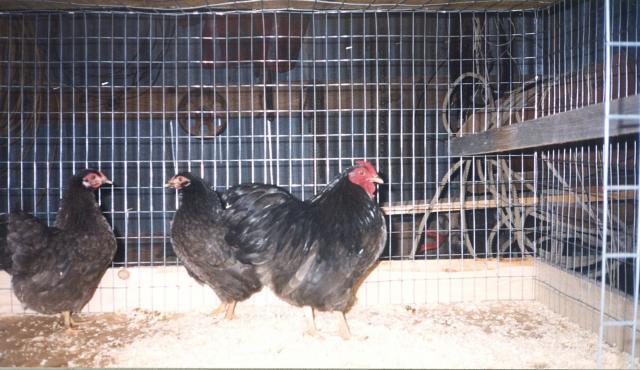- Jan 10, 2010
- 964
- 47
- 181
Alright since I am in the posting mood I am going to type out the article written by Dr Petty about creating and breeding Dun Partridge Wyandotte bantams. Hope you enjoy.
The Dun Partridge Wyandotte bantam project was an off shoot of the self Dun Wyandotte Bantam project.
Some of the cockerels in the self Dun project showed gold(red) in their hackle and saddle feathers. This was due to the wheaten hen which was used to introduce the Dun color(she was a dun Wheaton). After a study of the literature on wheaton as a pattern and color, I decided to try a cross of one of these cockerels with two Partridge Wyandotte bantam hens. The chicks produced in 1990 were all dark Partridge pattern. The females I kept really had nice pencilling and laid nice brown eggs.
It was noted that the gene for Dun reduces both the black and gold(red) in cockerel and pullet feather patterns. Both are attractive as the dun inhibitor(I d) softens the intensive coloring; black appears as a dark chocolate and gold(red) is lightened to a light burnt red.
In 1992, a mating of a Dun Partridge cockerel with two of his half sisters produced chicks which were of three colors; 25% Partridge(black pencilling), 50% were dark Dun Partridge(dark dun pencilling), and 25% were light Dun Partridge(light dun pencilling). The dark Dun Partridge is heterozygous for Dun inhibitor, only one gene for dun. The light Dun Partridge is a homozygous for Dun inhibitor, with two genes for dun. The light Dun Partridge is a pastel tan on a soft pastel brown red base color. The male is stroking in his color pattern.
To improve tpe and fine color pattern, I was assisted in the project by V. L. (Doc) Patterson who shared one of his fine Partridge cockerels with me in the 1992 show season. I mated this nice bird in Partridge with two Dun Partridge pullets in 1993. The young birds showed the improved type and pencilling.
During the 1994 season I mated brothers in Dark Partridge to their half sisters. All were from the Patterson mating of 1992. Again producing birds in three colors,; Partridge, Dark Dun Partridge and light Dun Partridge.
I am not sure this color pattern will be continued, as I had to disperse my stock to others due to health problems.
The Dun Partridge Wyandotte bantam project was an off shoot of the self Dun Wyandotte Bantam project.
Some of the cockerels in the self Dun project showed gold(red) in their hackle and saddle feathers. This was due to the wheaten hen which was used to introduce the Dun color(she was a dun Wheaton). After a study of the literature on wheaton as a pattern and color, I decided to try a cross of one of these cockerels with two Partridge Wyandotte bantam hens. The chicks produced in 1990 were all dark Partridge pattern. The females I kept really had nice pencilling and laid nice brown eggs.
It was noted that the gene for Dun reduces both the black and gold(red) in cockerel and pullet feather patterns. Both are attractive as the dun inhibitor(I d) softens the intensive coloring; black appears as a dark chocolate and gold(red) is lightened to a light burnt red.
In 1992, a mating of a Dun Partridge cockerel with two of his half sisters produced chicks which were of three colors; 25% Partridge(black pencilling), 50% were dark Dun Partridge(dark dun pencilling), and 25% were light Dun Partridge(light dun pencilling). The dark Dun Partridge is heterozygous for Dun inhibitor, only one gene for dun. The light Dun Partridge is a homozygous for Dun inhibitor, with two genes for dun. The light Dun Partridge is a pastel tan on a soft pastel brown red base color. The male is stroking in his color pattern.
To improve tpe and fine color pattern, I was assisted in the project by V. L. (Doc) Patterson who shared one of his fine Partridge cockerels with me in the 1992 show season. I mated this nice bird in Partridge with two Dun Partridge pullets in 1993. The young birds showed the improved type and pencilling.
During the 1994 season I mated brothers in Dark Partridge to their half sisters. All were from the Patterson mating of 1992. Again producing birds in three colors,; Partridge, Dark Dun Partridge and light Dun Partridge.
I am not sure this color pattern will be continued, as I had to disperse my stock to others due to health problems.




